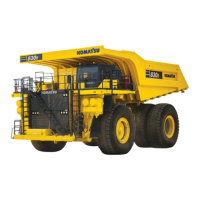D02023 24 VDC Electric Supply System D2-7
Maintenance Free types:
• Immediately after engine start, system volts are
lower than regulator setpoint with low amps.
• 15-30 minutes into charge cycle, still low volts
and low amps.
• 15-30 minutes into charge cycle, volts rise
several tenths, amps increase gradually then
increase quicker to medium to high amps.
• 20-35 minutes into charge cycle, volts rise to
setpoint and amps lower.
High-Cycle Maintenance Free Types:
These types respond much better than standard
maintenance free types. The charge acceptance of
these batteries may display characteristics similar to
standard, maintenance type batteries.
CHARGE VOLT AND AMP VALUES
Voltage and amperage levels are functions of battery
state of charge. If the batteries are charged 95% or
higher when the engine is cranked, the charge volt-
age will be near regulator setpoint and the amps will
taper quickly from medium to low. True battery volt-
age is obtained AFTER removing any surface charge
from the battery or after 24 hours of non-use.
DEFINITIONS
NOTE: Charge voltage and amp rates vary from
battery type to battery type, based on battery
construction technology and physical size of battery.
Low amps are the necessary amps that a battery will
take continuously over a period of time without dam-
age to the battery when the battery is in an operating
system and is constantly cycling. Batteries such as
the Group-8D may accept rates up to 15 amps over
several hours without raising their internal tempera-
ture more than a few degrees. Group-31 batteries
may accept rates up to 5 amps over several hours
with minimal temperature rise.
Medium amps are defined as some multiple of the
low amp value, perhaps 30 amps for the Group-8D
and 10-15 amps for the Group-31. This rate of
amperage will cause a rise in battery temperature
over a long period of time (4-8 hrs) and may lead to
an overcharge condition if temperature elevates too
high.
High amps would be 50 to 75 amps for a Group-8D,
and 25 to 35 amps for a Group-31 size. High amper-
age rates over a short period of time (2-3 hrs.) can
severely damage any battery by overheating the bat-
tery and causing thermal runaway. The battery, in
effect, forgets its state of charge and will accept all
amps offered. The electrolyte solution is boiled off as
the battery moves into an excessive gassing stage.
Charge voltage is the voltage delivered to the bat-
tery when the alternator and regulator are operating
properly. This charge voltage value is the voltage
regulator's setpoint. At times the charge voltage
value may be less than the regulator's setpoint but it
will never be higher than that setpoint.
Battery voltage is the steady state voltage of the
battery. The value of this voltage relates directly to
state of charge.
B+ voltage is battery positive voltage, but does not
refer to a specific value as does battery voltage.
Surface charge is a higher than normal terminal
voltage a battery has when it comes off a charger or
after extended time in vehicle operation. The surface
charge must be removed to determine true battery
voltage.

